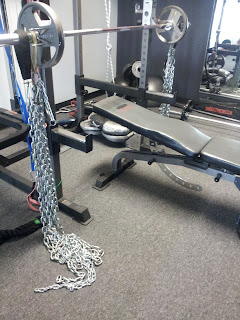Chains = Variable Resistance
When you lift with chains, the weight gets
heavier at the top of the movement. Each time a chain link leaves the ground,
you’re lifting the weight of that chain link, so you’re lifting a little more.
Well, as you lift each of the chain links
off the ground, the weight of the chains is released from
the floor and increases your load. The increasing load of the chains makes it
so you have to maintain
the greater force (or at least a portion of the force) you produced during the initial lift. You
have to keep exerting force to counteract the increasing load.
**NOTE: Usually, you exert the
most force at the bottom of the movement.
When you bench press with chains, the load increases as you press up since the chain links are
leaving the floor.
You have to keep exerting force throughout the top of the movement, as
the chain links leave the floor.
The load decreases as you lower the bar
since the chain links are going back to the floor. You exert less force as you approach the bottom of the
movement. The load increases during the concentric movement and decreases
during the negative movement.
When working with **CHAINS**: The weight
gets heavier as you lift it. You have to work harder to keep lifting it. The
load is the heaviest at the top of the lift. The weight gets
lighter as you bring it toward the ground. The load is the lightest at the bottom of the lift.
Force.
Work. Load. Power. Energy.










No comments:
Post a Comment